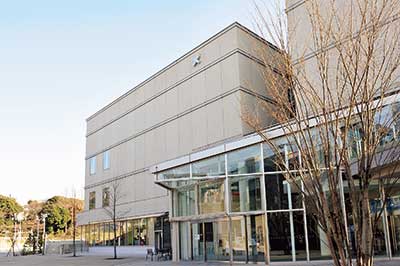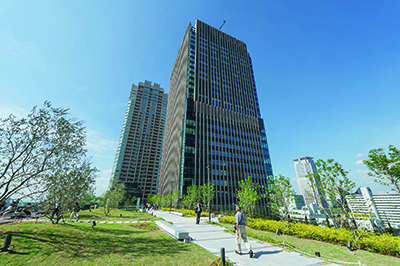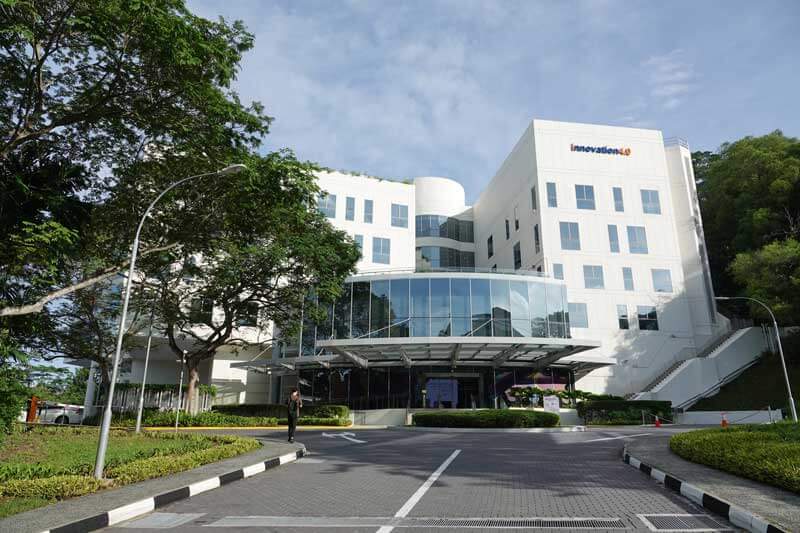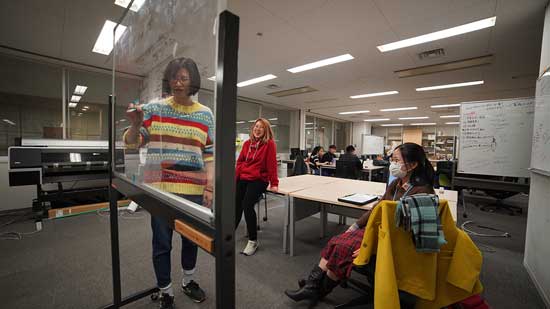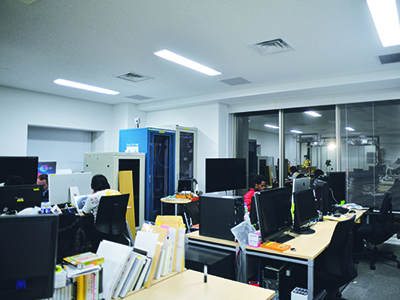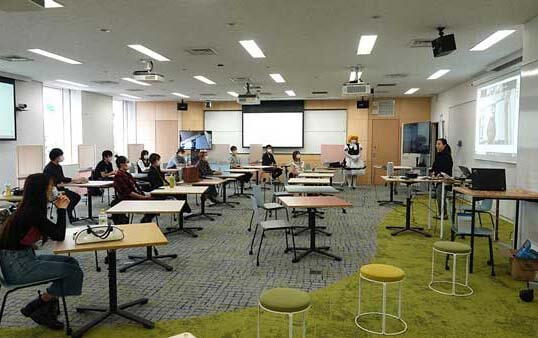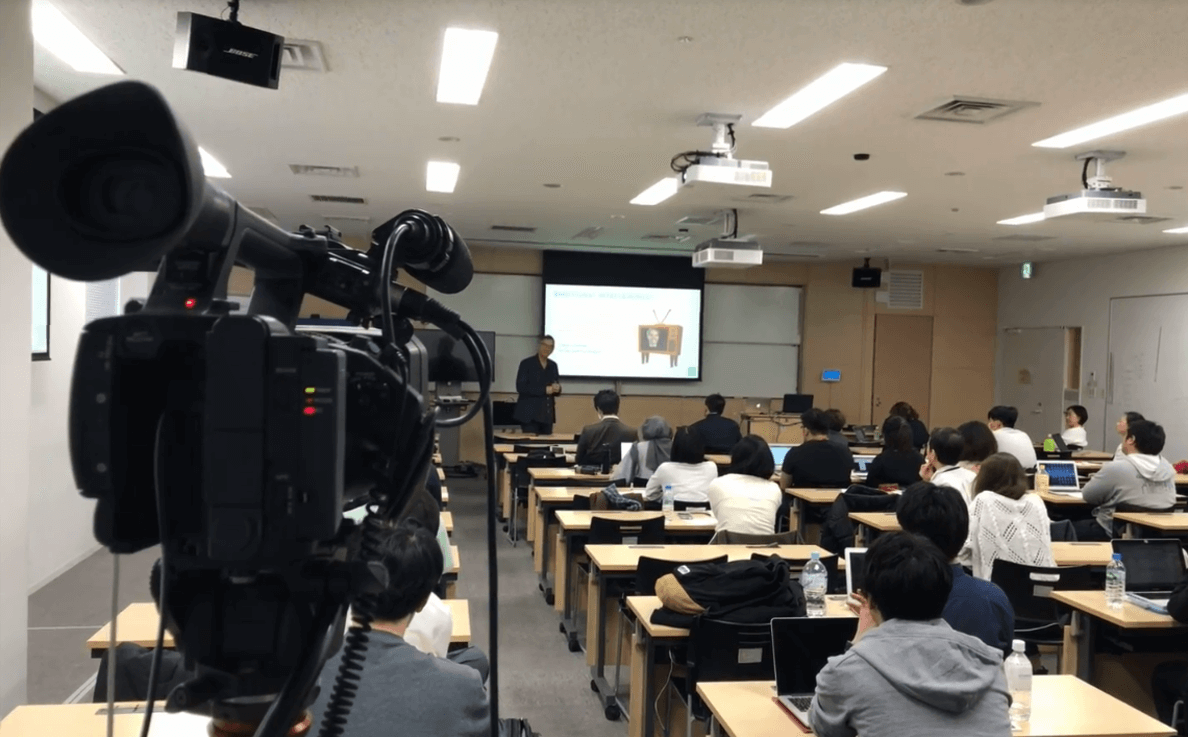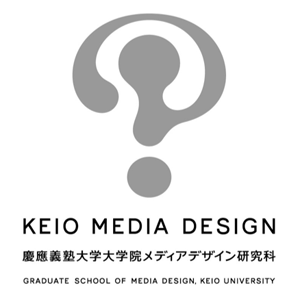
KMD trains students to become “media innovators,” our term for the globally oriented creative leaders who participate in the various activities that drive creative societies. Accordingly, we use English and Japanese as our official languages to ensure they can engage in leading-edge activities as members of the international community, while maintaining an environment that is designed to maximize our state-of-the-art network infrastructure. Furthermore, the curriculum and its integrated projects focus on the three pillars detailed below to ensure students are able to “MAKE,” “DEPLOY,” and have an “IMPACT” on the international stage.
1.Innovation Pipeline
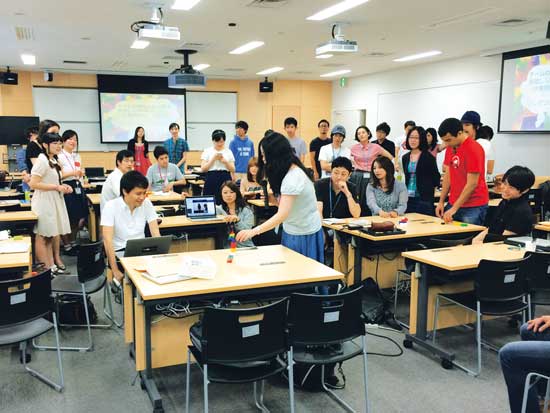
KMD views the creation of innovation as a continuous process, which we describe as “MAKE,” “DEPLOY,” and “IMPACT,” and adopts an educational model called the “innovation pipeline.” “MAKE” refers to an iterative “Build to Think” process of developing and proposing ideas that are verified through ethnographies and prototyping, encouraging students to think about and evolve their ideas as they build. KMD provides an environment with facilities that allow students to put this process into practice. In the “DEPLOY” phase, students work to release prototypes in society and learn how to accelerate new ventures and to promote and present their ideas more effectively. In the “IMPACT” phase, they learn strategies for both developing new fields and disrupting extant fields (large scale innovation) with the objective of spawning the value required to support creative societies.
2.Diversity

In the global community, it is crucial that we understand and respect the nature of local economies and cultures, as well as one another’s expertise and sense of values. KMD strives to mold a “community” at the school that stresses the importance of diversity. Nearly 40% of KMD students come to Japan from various regions around the world, and students can experience diverse cultures and social values firsthand. There is also a broad-spectrum of academic backgrounds among the students admitted, with many having already gained business experience, and KMD is home to a manifold of specialisms. Another characteristic of the KMD community is its wide-range of age groups. KMD highly values diversity in its many forms and the synergy it creates. Our students encounter diversity in a variety of ways on a daily basis, which allows them to learn to understand, respect, and value each other.
3.Radical Collaboration
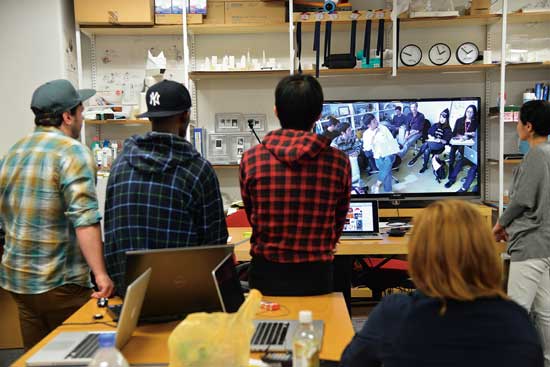
Team activities combining different areas of expertise and experience that exceed the abilities of any one individual is essential for creating innovation. KMD has built an environment that facilitates the serendipity of chance encounters with people from distinct backgrounds. Serendipity breeds novel ideas that serve as starting points for innovation. What begins as serendipity turns into synergy; this is how breakthroughs occur. In order to realize collaboration not only within KMD but externally, particularly globally, KMD has introduced a high-definition video conference system in addition to establishing satellite campuses in Osaka and Singapore with Hiyoshi Campus serving as the headquarters. Furthermore, the CEMS, GID, and EBA programs each offer students shared curricula with other globally ranked graduate schools.
4.Mission
The mission of KMD is to develop creative leaders and innovators who have the ability to globally collaborate beyond disciplines and cultures to innovate create social value. The official language of KMD is both English and Japanese. The curriculum is structured to have practical projects with external partners at its core, to acquire practical skills and theories including research and development of advanced digital technology, project management under multi-location and cultural environment, product and service design, business model and policy recommendations.
5.Principles of Education
● Diploma Policy
Training for leaders who can put new perspectives into practice is urgently required in order to realize a more sustainable society. To design future post-pandemic societies, three literacies are essential: futures literacy to envisage what is to come, innovation literacy for thinking outside the box unfettered by prevailing values and perspectives, and media literacy to accelerate activities that blend cyber-physical spaces. KMD prepares students for becoming the leaders of tomorrow by acquiring these three literacies and an appropriate mindset through praxis.
In the master’s program, students apply a comprehensive perspective grounded in the three literacies they have learned to the real projects in order to write a master’s thesis. In the doctoral program, students prepare a doctoral dissertation proposal on research that has implications for future society under the supervision of their academic advisor. When ready, a Dissertation Advisory Committee is formed, and students who pass the committee’s review become doctoral candidates. Students begin writing a draft of the doctoral dissertation after receiving permission from the Advisory Committee. Once they have submitted their draft, a Doctoral Dissertation Review Committee including external examiners is convened. Students need to reflect the amendments that are suggested by this committee into the final draft of their dissertation. After the final version is submitted, a public doctoral defense is held and the result reported by the Review Committee to the KMD Faculty Meeting, which is responsible for making the final decision on whether or not to award the degree.
● Curriculum Policy
The curriculum is designed for students to acquire three literacies: futures literacy to envisage what is to come, innovation literacy for thinking outside the box unfettered by prevailing values and perspectives, and media literacy to accelerate activities that blend cyber-physical spaces. In the introductory courses, students learn the fundamental hard and soft skills of the four areas of design, technology, management, and policy, while in the theory/strategy elective courses, students acquire an advanced conceptual understanding and perspective for designing a desirable future. At the heart of the curriculum is the real project. Students are expected to act on the three literacies to carry out the project and raise their level of expertise in their chosen field.
● Admissions Policy
Futures literacy requires curiosity, imagination, and future-orientated thinking. Innovation literacy demands flexible thinking and the fostering of a global perspective. Media literacy necessitates skills to facilitate the blending of and collaboration between cyber-physical spaces. KMD therefore seeks passionate, visionary students who are brimming with the creativity and compositional ability needed to take on the challenge of exploring uncharted territories. Applicants are evaluated based on their potential regardless of academic background. An interview will be held after the document screening.
6.The official names of the school, the major, and degrees we offer
● Name of School
Graduate School of Media Design
● Name of Major
Major in Media Design
● Degrees
Master of Media Design
Ph.D. in Media Design
● Student Body
Master's program: 80 students per year (total capacity of 160)
Doctoral program: 10 students per year (total capacity of 30)










